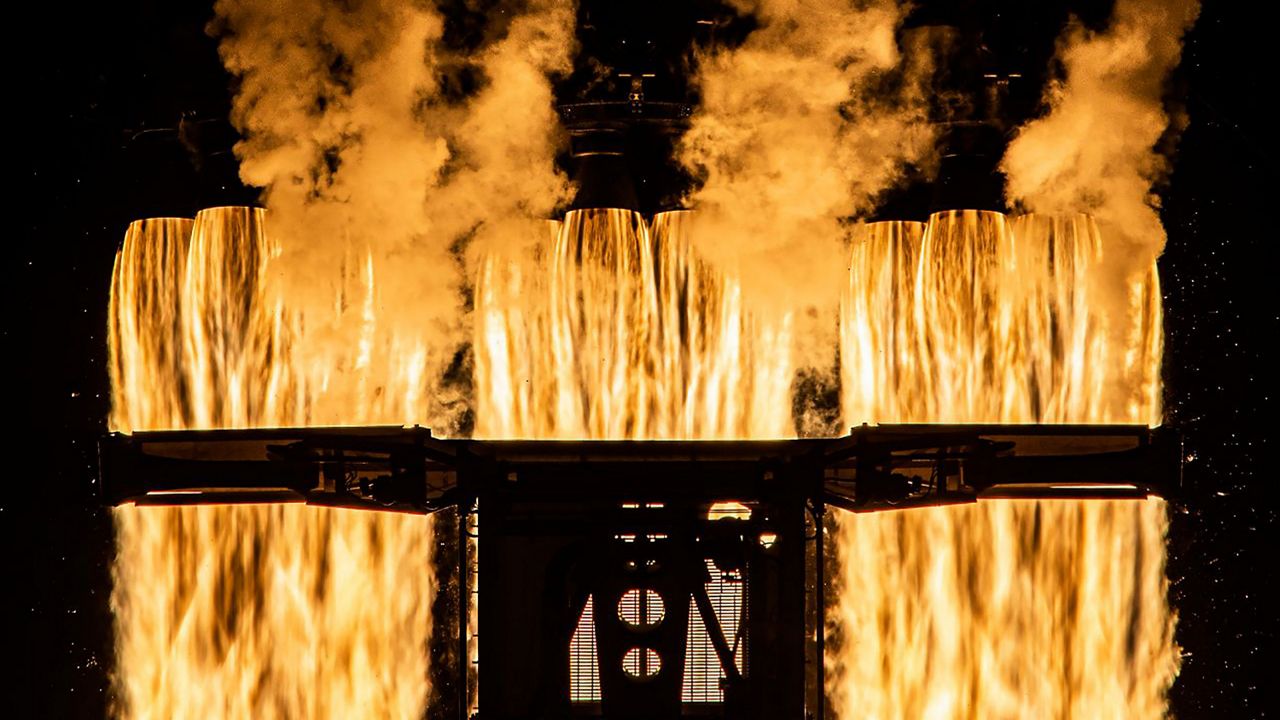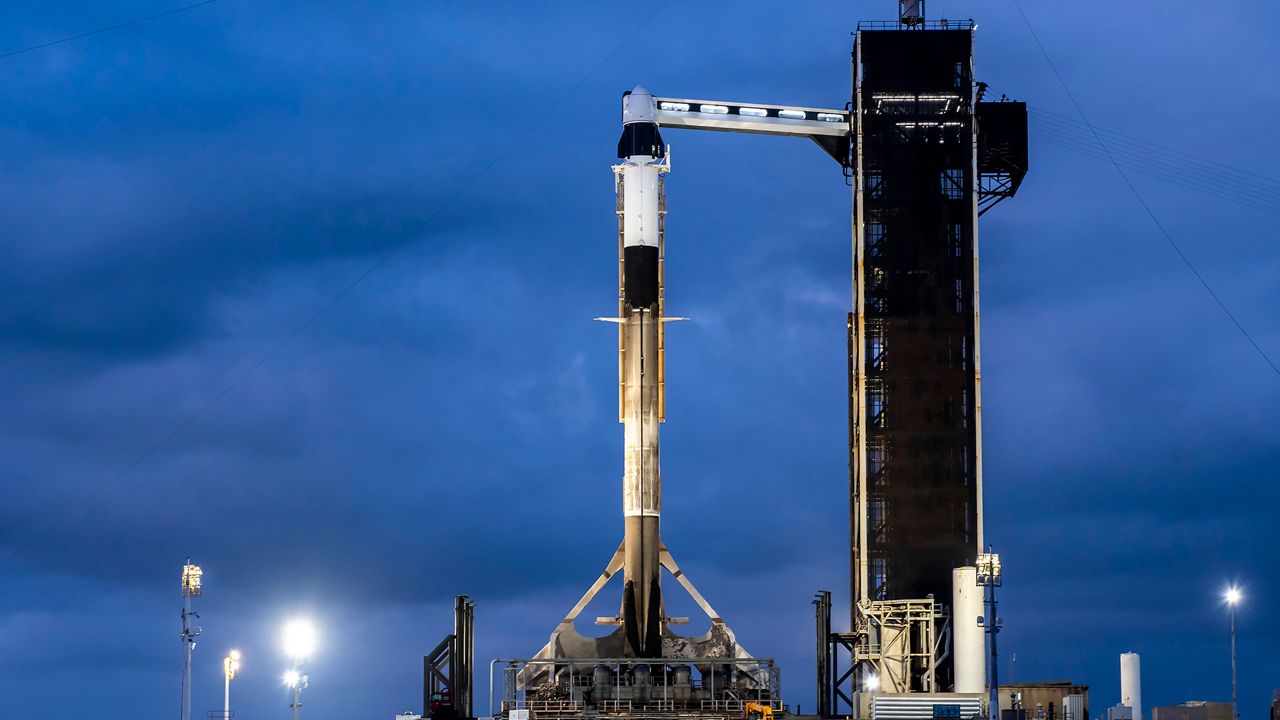KENNEDY SPACE CENTER, Fla. — A Sunday sunset launch from Florida’s Space Coast launched a new level of access to space for missions designed to help U.S. national security initiatives.
What You Need To Know
- USSF-67 mission was the first of the National Security Space Launch (NSSL) Phase 2 contract assignments to launch
- Sunday’s launch was the second national security mission to use a Falcon Heavy rocket
- One more NSSL mission with a Falcon Heavy is scheduled for 2023 with the USSF-52 mission
- The side boosters used on USSF-67 will likely be refurbished and reused on USSF-52
- RELATED coverage: SpaceX's Falcon Heavy launches top secret Space Force mission
Shortly before 6 p.m. EST, a Falcon Heavy rocket with two main spacecraft and five smaller payloads launched from Launch Complex 39A at NASA’s Kennedy Space Center. The mission, dubbed USSF-67, was the second national security launch using one of SpaceX’s Falcon Heavy rockets and the first time one of these missions used pair of side boosters making a repeat flight. These were first used in support of the USSF-44 launch in November 2022.
Drone shot of Falcon Heavy's side boosters landing at LZ-1 and LZ-2 pic.twitter.com/JfYRWDIi1j
— SpaceX (@SpaceX) January 16, 2023
SpaceX and its Falcon Heavy rocket were picked for the mission as part of the National Security Space Launch (NSSL) contracts in 2020. USSF-67 was one of three missions assigned as part of the first task order from Phase 2 of this contract along with two missions for United Launch Alliance (ULA):
- USSF-67 — SpaceX Falcon Heavy (launched Jan. 2023)
- USSF-51 — ULA Atlas V (originally set for Q2 2022)
- USSF-106 — ULA Vulcan Centaur (originally set for Q4 2022)
According to the 2022 U.S. Department of Defense FY23 Budget Request, the U.S. Space Force oversees two main buckets of launches: NSSL and Rocket System Launch Program (RSLP). It defines NSSL as “highly reliable launch services for medium and heavy lift class national security satellites” and the RSLP as the “procurement of small launch and rideshare services, suborbital targets and experimental flights, and restoration of excess ballistic missile assets for reuse.”
ULA, SpaceX, Northrop Grumman, Rocket Lab and VOX Space (a subsidiary of Virgin Orbit) are all prime contractors for RSLP, but only SpaceX and ULA are listed as prime contractors for the NSSL program.
Sunday’s USSF-67 mission was overseen by the U.S. Space Force’s Space Systems Command (SSC), which is responsible for “launch operations, on-orbit checkout, developmental testing sustainment and maintenance of military satellite constellations and other Department of Defense space systems.”
“This is a huge win for the entire space enterprise,” said Col. Joseph Roth, director, Innovation and Prototyping Acquisition Delta, in a statement. “Not only are we significantly increasing our launch and on-orbit mission capabilities, we are also demonstrating and strengthening our space operations footprint to ensure we can rapidly respond to any developing threats from our adversaries. My hats off to the entire total force team that made this launch a huge success.”
This evening, the second NSSL mission on a Falcon Heavy successfully launched, just two months after the first successful NSSL mission launched on the platform.
— Space Launch Delta 45 (@SLDelta45) January 16, 2023
USSF-67 marks the 3rd launch of the year for SLD 45 & the 96th consecutive successful NSSL launch. #SemperSupra pic.twitter.com/wqBNTkHSET
How did we get here?
Prior to launch, Spectrum News spoke with Dr. Walt Lauderdale, the chief of Falcon Systems and Operations at Space Systems Command (SSC). He said the partnership with SpaceX goes back to their first launch of a Falcon 9 rocket in 2010.
However, SpaceX’s first national security mission wouldn’t come until 2018 with the Global Positioning System (GPS) III space vehicle (SV) 01 satellite launch on a Falcon 9.
“When we talk about getting ready to launch, going back to 2018, which was our first launch with GPS III SV01, we’ve been on that journey with them, working questions, making sure we understand the technical baseline of the rocket and applying our own standards for independent mission assurance to make sure that the rocket is in a condition that we feel confident to launch on,” Lauderdale said.
Lauderdale worked with United Launch Alliance (ULA) in various roles at the Space and Missile Systems Center (SMSC) from August 2005 through May 2018 before transitioning to his current job working with SpaceX and its Falcon rockets.
SMSC became Space Systems Command in August 2021.
“It was an amazing opportunity for me, having worked Atlas and Delta for many years and now having the opportunity to work with SpaceX and to explore a new vehicle system and to do the same work to make sure that we deliver that capability to orbit, is just fantastic. Just a lot of fun,” Lauderdale said.
He said having multiple launch providers is important for SSC, both for national security missions and other operations.
“From a national security space standpoint, we want to make sure that we can have assurance to get those assets into orbit. So, having more than one provider is our way of making that happen,” Lauderdale said. “Now as we’ve evolved over the last 10 years, going from ULA with Atlas and Delta and now bringing SpaceX in, and you look at the explosion of providers, it becomes something that we have to continually work on to make sure that we can take advantage of the new commercial capabilities to make sure that we can deliver our mission capability for the warfighter whenever they need it.”
When it came to the Falcon Heavy rocket, which also debuted in 2018, it flew two missions prior to its first use by SSC. The U.S. Air Force Space Test Program-2 (USAF STP-2) launched on June 25, 2019, with Lauderdale serving as the mission director.
That was the third mission for the Falcon Heavy rocket and the first time it flew using two flight-proven side boosters, which Lauderdale said, “really laid the foundation for us to understand not just the Falcon Heavy, but then what it takes to reuse the side cores.”
According to a December 2021 National Security Space Launch (NSSL) Selected Acquisition Report (SAR), “The SpaceX Falcon Heavy launch system Non-Recurring Design Validation (NRDV) activities were completed on schedule in September 2020.”
The fourth Falcon Heavy became its first flight under the NSSL program and proved some additional capabilities, like reaching geostationary orbit, a circular orbit about 22,236 miles above Earth’s surface. For comparison, the International Space Station is parked in low Earth orbit at a distance of about 254 miles from Earth.
The Jan. 15, 2023 launch marked the fifth launch of a Falcon Heavy with the USSF-67 mission, which also went to geostationary orbit. It had the bonus of also using re-flown boosters, a first for the Falcon Heavy under the NSSL program.
“We have been following before, but now being able to do it ourselves with SpaceX for this time gives us some resiliency. It gives us some flexibility in working with SpaceX in terms of what rockets are available to support our missions and to be able to support it on-schedule to get that capability to orbit,” Lauderdale said. “So, that’s what I really mean by ‘game changer,’ because now we can take advantage of the commercial capability SpaceX has been maturing and use that to support our nation’s needs.”
Sped up tracking cam footage of Falcon Heavy from launch to landing pic.twitter.com/RKnRXEz7Gu
— SpaceX (@SpaceX) January 16, 2023
What comes next?
With the USSF-67 mission now in the books, the teams at SSC turn their attention to the next series of launches on their docket, including another one this week.
SSC and SpaceX are preparing to launch the GPS III SV06 mission from Space Launch Complex 40 (SLC-40) at Cape Canaveral Space Force Station on Wednesday, Jan. 18. The Lockheed Martin-built satellite, nicknamed “Amelia Earhart,” will be the fifth such satellite launched by SpaceX and will join 31 other GPS satellites currently in orbit.
It’s also the sixth of 10 planned GPS III missions.
The next Falcon Heavy to fly for SSC is the USSF-52 mission, which was previously dubbed Air Force Space Command (AFSPC)-52. The $130 million procurement was awarded in June 2018 to SpaceX as part of the Evolved Expendable Launch Vehicle (EELV) launch service contract. It was originally set to launch “in late Fiscal Year 2020,” but has been delayed. It is also the last announced Falcon Heavy for the NSSL program at this point.
During the USSF-67 launch broadcast, SpaceX Production Manager Jessie Anderson noted that “the side boosters will be refurbished and used in a future national security space launch.” With USSF-52 being the next on deck, it’s likely that boosters B1064-3 and B1065-3 will make their next appearance on this mission.
Lauderdale said even though some of SpaceX’s first-stage boosters have reached 15 flights, several factors go into whether a booster is ready for reuse.
“You get all the individual components that go into that booster and you look to see how much life does it have remaining. What’s my confidence that this particular component, can still work? And if you need to replace some, you replace some things, but that’s part of looking at what gives you the confidence that you can fly again,” Lauderdale said.
The next couple of years of NSSL Phase 2 awards were also distributed between ULA and SpaceX. Year 2 awards came out to $225 million for ULA and $160 million for SpaceX.
- Order Year 2 Task Orders (placed March 9, 2021)
- USSF-36 — SpaceX (Falcon9, scheduled Q2 FY23)
- USSF-112 — ULA (Vulcan Centaur, scheduled Q3 FY23)
- USSF-87 — ULA (Vulcan Centaur, scheduled Q4 FY23)
- NROL-69 — SpaceX (Falcon 9, scheduled Q4 FY23)
- Order Year 3 Task Orders (placed May 26, 2022); no launch dates announced
- GPS III SV07 — ULA Vulcan Centaur
- USSF-23 — ULA Vulcan Centaur
- USSF-43 — ULA Vulcan Centaur
- Wideband Global SatCom (WGS) 11+ — ULA Vulcan Centaur
- USSF-16 — ULA Vulcan Centaur
- USSF-124 — SpaceX Falcon 9
- USSF-62 — SpaceX Falcon 9
- SDA Tranche 1 — SpaceX Falcon 9
All of the Order Year 3 missions will launch from Florida with the exception of USSF-62 and the Space Development Agency (SDA) Tranche 1 Transport Layer mission (first of six planned missions). Both missions will launch to a polar orbit from Vandenberg Space Force Base in California. ULA received $556 million for its five missions and SpaceX received $280 million for its three.
“It’s an exciting time to be down here on the Space Coast. We’ve commented and we’ve heard it by others, saying there’s going to be huge launch rate here,” Lauderdale said. “I think what’s gonna be most exciting is being able to see how we all come together as a community both here at Patrick, at KSC, Cape Canaveral, how we integrate our operations together to enable that kind of launch rate.”
“When you think about it, to have that kind of launch rate … and have the confidence that this whole team down here, and also at Vandenberg Space Force Base, we can still deliver that capability because this whole integrated team together makes it happen. And it’s terrific to see.”








